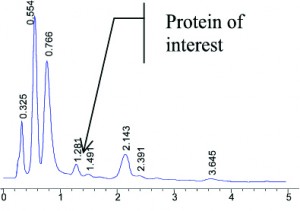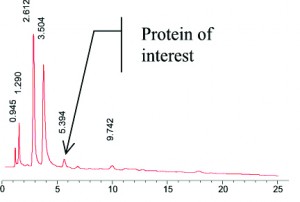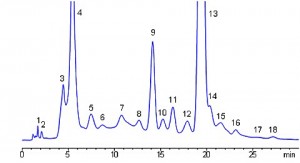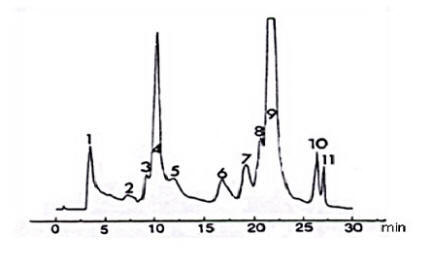-
Facts About STYROS® Stationary Phases
-
Frequently Asked Questions
Thanks to you, our loyal and ever-growing customers, we have done it for over 25 consecutive years and counting.
The price of an 8 ml Mono Q or Mono S column is now over $6,000 as compared to under $2,000 for a STYROS® column equivalent.
A 20 ml STYROS® column is still less expensive than a Mono Bead column sold in 1997 (under $5,000).
Scalability with STYROS® columns is seamless, from 100 mm long 4.6 mm ID column, to 100 mm long 10 mm ID column of similar resolution.

Separation of cell culture with a
4.6 x 100 mm STYROS® HQ/XH column(volume = 1.7 ml)
Flow rate 5 ml/ min (1,800 cm/hr of linear velocity)

Scale up of the same separation of cell culture with a
10 x 100 mm STYROS® HQ/XH column (volume = 8 ml )
Flow rate 5 ml/ min (380 cm/hr. of linear velocity)
- STYROS® is made of highly cross linked Poly (Styrene-divinylbenzene) as compared with low cross linked polymeric soft gels.
STYROS® can routinely be used at 207 to 276 bar (2,000 to 3,000 psi). This provides the option of having longer columns, to be used not only with low pressure chromatography systems, but also with high pressure, high performance systems for faster separation and results.
OraChrom offers columns ranging in ID from 0.175 mm to 20 mm, and lengths of 1 to 250 mm.
- STYROS® HQ Anion exchanger compared with Mono Q from former Pharmacia, now GE Healthcare.

Separation of mucin free egg white proteins on STYROS® HQ/XH
strong anion exchanger.
(Linear Flow Rate: 360 cm/hr)

Separation of mucin free egg white proteins on Mono Q HR
(Linear Flow Rate: 300 cm/h
See the Application notes for more facts and column performances.
Recent Applications of STYROS® Stationary Phases are listed beleow:
- 75: STYROS™ Amino-HILIC Simulated Monolith™ Polymeric Normal Phase: Separation Nucleosides Intended for MS. No Bleed
- 76: STYROS™ HILIC Simulated Monolith™ Polymeric Normal Phase: Separation of Adrenaline and Noradrenaline Intended for MS. No Bleed
- 77: STYROS™ HILIC Simulated Monolith™ Polymeric Normal Phase: Separation of Dopamine and L-Dopa for MS. No Bleed
- 78: STYROS™ HILIC Simulated Monolith™ Polymeric Normal Phase: Separation of Methyladrenaline and Methyldopa Intended for MS.No Bleed
- 79: STYROS™ HQ Simulated Monolith™ Polymeric: Separation of Protein Mixtures
- 80: STYROS™ HQ Simulated Monolith™ Polymeric: Loading Study
- 81: Practical Use of STYROS™ HQ Simulated Monolith™ Polymeric In the Separation of Hemoglobin Variants
- 82: Separation of Soybean Trypsin Inhibitor wiht STYROS™ HQ Simulated Monolith™ Polymeric
- 83: Practical Use of STYROS™ HQ Simulated Monolith™ Polymeric In the Separation of OVA Variants
- 84: Practical Use of STYROS™ HQ Simulated Monolith™ Polymeric In the Separation of Hemoglobin and Methemoglobin
- 85: Use of STYROS™ HQ Simulated Monolith™ Polymeric in the Quality Control of Incoming Lots
- 86: STYROS™ HQ Simulated Monolith™ Polymeric. Importance of Column Length
- 87: Practical Use of STYROS™ HPA Simulated Monolith™ Polymeric In the Separation of OVA Variants
- 88: Practical Use of STYROS™ HPA Simulated Monolith™ Polymeric In the Separation of Hemoglobin Variants
- 89: Practical Use of STYROS™ HPA Simulated Monolith™ Polymeric In the Separation of Hemoglobin and Methemoglobin
Frequently Asked Questions
Q: What is different with your Polymeric Stationary Phases?
A: Polymeric stationary phases are offered with different degree of cross-linking.
STYROS® products are optimally cross-linked to provide “Hard Gel” that equals the pressure tolerance of Silica without the rigidity and brittleness of Silica.
- There is no risk of dissolution of or leakage from the stationary phase.
- They can withstand extreme pH’s during clean up or sanitization procedures.
- They have therefore a low turnover of highly priced prep columns.
Q: How high of back pressure can it stand?
A: We have tested it up to 10,000 psi without collapsing the bed.
Q: Are you suggesting that there is no leaching or leakage?
A: Indeed, the column can last many years as the bed remains intact.
Provided that the column is properly used and cleaned after usage in order to avoid the fouling of the bed or the plugging of the frit, the media will not degrade. There is no leaching.
Q: Polystyrene divinylbenzene polymers are hydrophobic, how do you make it hydrophilic? Is there any “shrink-wrapping” involved?
A: No “shrink-wrapping” as the stationary phase is fully porous and therefore fully pervious. Any passive coating such as “shrink-wrapping” would plug the through pores during the passive coating. The coating would naturally leach out during the operation and subsequently create a void.
Q: How are you then coating it?
A: Bonding. Covalent bonding using proprietary chemistry. The coating is such that it does not leave any nonspecific patches on the surface of the stationary phase.
The coating neither leaches nor does it plug the through pores.
Q: How do you compare the performance of the media before and after the coating?
A: Considering the orthogonal change in property, the performances compare favorably.
Q: Are there benefits to Polymeric HPLC columns.
A: There are many. The obvious one is the fact that there is no need to functionalize them for reversed-phase separations, and
- They are pH resistant from 1 to 14
- They are chemical resistant
- They can stand temperatures over 60 °C
- Samples are fully recovered
- They have the longest average life span.
- There is no issue of “phase collapse” in aqueous solvent. These characteristics are needed for the operation to be reproducible.
- No need for “Polishing”. The stationary phase does not leach as all other stationary phases on the market do.
STYROS® columns are made rigid. They can withstand high back pressures. They are not brittle as Silica and they do not leach.
In addition to these advantages they are offered in anion exchange, cation exchange, HIC, HILIC, Affinity including Protein A.
StyrosZyme® Enzyme Reactor Columns are a line of products that reduce the digestion process of proteins to a few minutes as opposed to hours with no leaching and no enzyme auto digest contamination. These are also polymer based that are routinely used in total automation in digestion and mapping of proteins without the need for prior treatment of substrate.
This line of products are further proof of the stability of the product and the claim of no leaching.
As “Simulated Monolith™” our own proprietary process of manufacturing the media, STYROS ® offers the added advantage of low back pressures while maintaining high resolution similar to Monoliths.
The low back pressures are such that they have been used with HPLC instruments as well as with FPLC.
The “Wall Effect” and “Size Limitation” of Monolith no longer applies with “Simulated Monolith™”.

